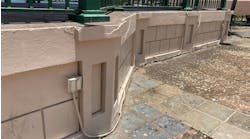How well do you know the Code? Think you can spot violations the original installer either ignored or couldn't identify? Here's your chance to moonlight as an electrical inspector and second-guess someone else's work from the safety of your living room or office. It's your turn to identify the violation.
Hint: Really “high” voltage
Find the Answer
This installation gives new meaning to the term “high voltage.” This photo was sent in by Chris Capozzi, electrician and owner of CTC Electric LLC in Pittsburgh, Pa.
“That panel has got to be at least 12 ft in the air,” said Capozzi. “I wonder how they access the circuit breakers?”
Chris, thanks for sharing this great photo with us. I also wonder how anyone could reach the breakers in that panel mounted above the switchboard. Section 240.24(A) generally requires overcurrent devices to be installed so that the operating handle of the device is not more than 6 ft, 7 in. above the floor or working platform.
Another issue of concern is what appears to be some fire sprinkler piping located directly above the switchboard. Sprinkler piping located in this area would violate the dedicated space requirements of Sec. 110.26(E). No systems foreign to the electrical installation may be located directly above this switchboard for a height of 6 ft above the switchboard.
But I do see something positive with this installation. Check out the yellow marking lines on the floor. While not required by the Code, these lines are a great way to identify the working space area required to be kept clear in front of this electrical equipment.





